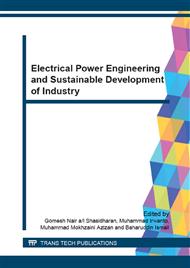[1]
Weidman, C. D., and E. P. Krider (1979), The radiation field waveforms produced by intracloud lightning discharge processes, J. Geophys. Res., 84, 3159–3164. Le Vine, (1980).
DOI: 10.1029/jc084ic06p03159
Google Scholar
[2]
Le Vine, D. M., J. C. Willett, and J. C. Bailey (1989), Comparison of fast electric field changes from subsequent return strokes of natural and triggered lightning, J. Geophys. Res., 94, 13, 259–13, 265.
DOI: 10.1029/jd094id11p13259
Google Scholar
[3]
Cooray, V., and S. Lundquist (1982), On the characteristics of some radiation fields from lightning and their possible origin in possible origin in ground flashes, J. Geophys. Res., 87(C13), 11, 203–11, 214.
DOI: 10.1029/jc087ic13p11203
Google Scholar
[4]
Cooray, V., Lundquist, S., 1985. Characteristics of the radiation fields from lightning in Sri Lanka in the tropics. Journal of Geophysical Research 90, 6099–6109.
DOI: 10.1029/jd090id04p06099
Google Scholar
[5]
Bils, J.R., Thomson, E.M., Uman, M.A., 1988. Electric field pulses in close lightning cloud flash. Journal of Geophysical Research 93 (D12), 15933–15940.
DOI: 10.1029/jd093id12p15933
Google Scholar
[6]
Villanueva, Y., Rakov, V.A., Uman, M.A., Brook, M., 1994. Microsecond-scale electric field pulses in cloud lightning discharges. Journal of Geophysical Research 99 (D7), 1453–1460.
DOI: 10.1029/94jd01121
Google Scholar
[7]
Weidman, C. D., and E. P. Krider (1978), The fine structure of lightning return stroke wave forms, J. Geophys. Res., 83(C12), 6239–6247.
DOI: 10.1029/jc083ic12p06239
Google Scholar
[8]
Master, M. J., M. A. Uman,W. H. Beasley, and M. Darveniza (1984), Lightning induced voltages on power lines: experiment, IEEE Trans. PAS, 103, 2519–2529.
DOI: 10.1109/tpas.1984.318406
Google Scholar
[9]
Rakov, V. A., M. A. Uman, D. E. Crawford, J. Schoene, J. Jerauld, K. J. Rambo, G. H. Schnetzer, B. A. DeCarlo, and M. Miki (2003).
Google Scholar
[10]
Willett, J. C., J. C. Bailey, V. P. Idone, A. Eybert-Berard, and L. Barret (1989), Submicrosecond fields and currents in triggered lightning return strokes based on the transmission line model, J. Geophys. Res., 94, 13, 275–13, 286.
DOI: 10.1029/jd094id11p13275
Google Scholar
[11]
Thottappillil, R., and M. A. Uman (1993), Comparison of return stroke models, J. Geophys. Res., 98(D12), 22, 903–22, 914.
DOI: 10.1029/93jd02185
Google Scholar
[12]
Cooray, V., R. Montano, and V. Rakov (2004), A model to represent negative and positive lightning first strokes with connecting leaders, J. Electrostatics, 60, 97–109.
DOI: 10.1016/j.elstat.2004.01.016
Google Scholar
[13]
Jerauld, J., M. A. Uman, V. A. Rakov, K. J. Rambo, and D. M. Jordan (2004), A triggered lightning flash containing both negative and positive strokes, Geophys. Res. Lett., 31, L08, 104, doi: 10. 1029/2004GL019457.
DOI: 10.1029/2004gl019457
Google Scholar
[14]
Z.A. Baharudin, M. Fernando, Noor Azlinda Ahmad, J.S. Makel, MahbuburRahman, Vernon Cooray (2012).
Google Scholar
[15]
Noor Azlinda Ahmad, M. Fernando, Z.A. Baharudin , M. Rahman, V. Cooray (2010) The first electric field pulse of cloud and cloud-to-ground lightning discharges, Journal of Atmospheric and Solar-Terrestrial Physics 72 (2010) 143–150.
DOI: 10.1016/j.jastp.2009.11.001
Google Scholar
[16]
ZiadSaleh b, Joseph R. Dwyerb, Hamid K. RassoulbSharma, S.R., Fernando, M., Gomes, C., 2005. Signatures of electric field pulses generated by cloud flashes. Journal of Atmospheric and Solar–Terresterial Physics 67, 413–422.
DOI: 10.1016/j.jastp.2004.09.007
Google Scholar


